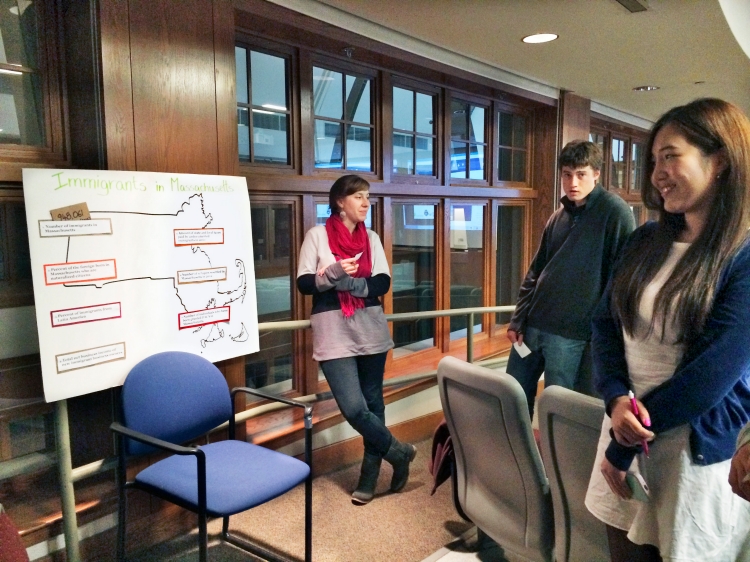
By
Boston College undergraduates’ volunteer activities often involve working with immigrants in a variety of settings and circumstances. But how much do students really know about the social, legal, political, demographic and other aspects of immigration in the United States?
This fall, BC’s Center for Human Rights and International Justice (CHRIJ) – marking its 10th year – has organized events and offered resources to help undergraduates better understand the context in which their service to immigrants takes place.
In October, CHRIJ invited students – particularly those in the PULSE and 4Boston programs – to a pair of workshops that provided a primer on immigration, including statistical portraits of the immigrant populations in Boston and the US, an overview of immigration and deportation policies, and a look at local and national debates over immigration issues.
The center also has made available an online guide to help English for Speakers of Other Languages teachers integrate discussion about immigration and human rights into their instruction. The Know Your Rights and English for Speakers of Other Languages (KYR/ESOL) Tool Kit, developed by the center with ESOL teachers at Casa El Salvador and Women Encouraging Empowerment in Massachusetts, includes units centered on subjects that are of special concern to migrants, whether legal citizens, documented or undocumented.
CHRIJ administrators are quick to emphasize that they are not grooming undergraduates to take the place of legal advisors or other professionals who work with immigrant populations. The purpose of the center’s outreach, they say, is to help reinforce an important aim of BC service programs: that students be able to connect their volunteer experiences to events and situations in the wider world.
“We’re trying to get students to put themselves in the shoes of the immigrants with whom they interact – what are their struggles, what questions do they face, what are their needs - from both legal and psychosocial perspectives,” says CHRIJ Assistant Director Timothy Karcz. “To do that, it’s important to look at the bigger context of immigration in this country and in the Boston area, and how it is influenced by various factors.
“This also was an opportunity to introduce the undergraduates to the center’s work as it relates to immigration,” he adds. “It is mainly graduate and professional students who tend to work on our research projects, but we want to show that we can be a resource for the rest of the University community as well.”
Adds Jessica Chicco, a supervising attorney for the center’s Post-Deportation Human Rights Project, “Our message was that what we were presenting was basic information, and did not make them experts on immigration. Some students receive significant orientation or background on immigration as part of their service, but not all do. They should be aware they are working with an immigrant community in a rich, nuanced context, and be sensitive to the issues at hand.”
Undergraduates attending the October workshops watched a documentary about the recent influx of unaccompanied immigrant children in the US, and the response it has generated. Organizers also set up several displays to deepen students’ insights on immigration: One featured immigrants’ stories told in first person, for example, while others provided easy-to-read overviews of immigration-related statistics, policies and laws.
Students also were invited to test their knowledge about immigration, Chicco notes. Some answers revealed misperceptions: that undocumented immigrants pay nothing in taxes, for example, or that immigrants “automatically” get green cards.
Chicco feels the workshops made an impression. “One student said, ‘Many of the people I work with have this threat of deportation hanging over their heads.’ And another undergraduate even talked about perhaps becoming an immigration lawyer. So if they can see that these issues are there in front of them, it makes their service work even more meaningful.”
The idea for the KYR/ESOL Tool Kit, says Chicco, came about from observations among immigration advocates on the popularity of ESOL classes: “Contrary to what’s often said, most immigrants want to learn English, so they can navigate the multiple systems they encounter in the US.” Given changes in immigration law, increased enforcement programs and the possibility of racial profiling or police mistreatment, CHRIJ and the advocates felt that ESOL classes could foster an awareness of, and a vocabulary for discussing, legal and human rights issues faced by immigrants, documented or undocumented.
One unit in the tool kit introduces ESOL students to the concept of human rights and their significance to the immigrant community, and encourages discussion among class members about their own views. Another unit focuses on a specific, and common, situation: Through role-playing and other means, the ESOL students learn appropriate responses, verbal and otherwise, if stopped by the police while driving.
“It’s a tool kit – we’re not asking teachers to replace their curriculum, but to supplement it,” says Chicco. “Nor is this legal advice: We encourage teachers to consult with a lawyer or advocacy organization if they have questions.
“We just want people who teach ESOL – including BC students – to think about infusing these concepts into their English instruction.”
Karcz says the center continues to mull future events or programs – such as a series of lunchtime presentations – that would be aimed at undergraduates. “We’re trying to identify topics they’d like to hear about, and then explore ways of engaging with them. Above all, we want them to know about us and what we do.”
For more about the Center for Human Rights and International Justice, see www.bc.edu/chrij.



